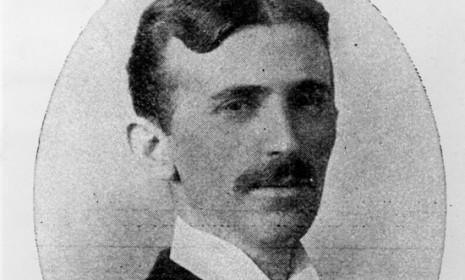5 crazy inventions from the mind of Nikola Tesla
Earthquake machines! Death rays! Those far-fetched gadgets are part of a plan to build a museum dedicated to one of history's most famous mad scientists

Matthew Inman, proprietor of web comic The Oatmeal, is on a mission to build a crowd-funded museum dedicated to inventor Nikola Tesla, who Inman refers to as "the greatest geek who ever lived." Inman's goal was to raise $850,000 (which would be matched dollar-for-dollar by a New York state grant) in 45 days. But surprisingly, a little more than a week into it, the online campaign has gathered more than $1.1 million in donations. Many of the inventor's fans think Tesla was more brilliant than his more famous contemporaries, including Alexander Graham Bell and Thomas Edison. Even though Tesla isn't exactly a household name, his unsung accomplishments and wild imagination have turned him into something of a folk hero. Here, a rundown of five of Tesla's craziest inventions:
1. Wireless energy transfer
About 120 years ago at the 1893 World Fair in Chicago, Tesla demonstrated that you could wirelessly transmit electricity by firing up a series of phosphorous light bulbs in a process he called electrodynamic induction. He dreamed that such technology would allow us to one day shoot power over long distances in the atmosphere, supplying distant destinations with the energy needed to live comfortably. Now over a century later, companies such as Intel and Sony are interested in applying the non-radiative energy transfer to things such as cell phones to allow you to charge your battery without messy power cables.
The Week
Escape your echo chamber. Get the facts behind the news, plus analysis from multiple perspectives.

Sign up for The Week's Free Newsletters
From our morning news briefing to a weekly Good News Newsletter, get the best of The Week delivered directly to your inbox.
From our morning news briefing to a weekly Good News Newsletter, get the best of The Week delivered directly to your inbox.
2. X-rays
Tesla's research in the field of electromagnetism helped give radiologists everywhere the ability to peer into a person's anatomy without cutting them open — a concept that, in the late 1800s, sounded far-fetched. Although German physicist Willhelm Röntgen is widely credited with the discovery of X-rays in 1895, Tesla's own experiments with the technology eight years prior highlighted some of the inherent dangers of using radiation on human flesh.
3. Death ray
In the 1930s Tesla reportedly invented a particle beam weapon that some, ironically, called a "peace ray," says Lauren Davis at io9. "The device was, in theory, capable of generating an intense targeted beam of energy" that could be used to dispose of enemy warplanes, foreign armies, "or anything else you'd rather didn't exist." The so-called "death ray" was never constructed, however, even though Tesla shopped the device around to various military divisions. The plans for the laser were never found after Tesla's death.
A free daily email with the biggest news stories of the day – and the best features from TheWeek.com
4. Robotics
Tesla imagined that, in the future, a race of robots "would be able to perform labor safely and effectively," says io9's Davis. In 1898, he demonstrated a radio-controlled boat he'd invented, which many credit as "being the birth of robotics." He envisioned a world filled with "intelligent cars, robotic human companions, [various] sensors, and autonomous systems."
5. Earthquake machine
"In 1898, Tesla claimed he had built and deployed a small oscillating device that, when attached to his office and operating, nearly shook down the building and everything around it," says Shea Gunther at Revmodo. The device weighed just a few pounds, but Tesla was able to tune the timing of the oscillator at such a frequency that each little vibration added just a little more energy to the wave of flex in the building. "Given enough little pushes, even the largest structure could be shaken apart." Realizing the potential terrors such a device could create, "Tesla said he took a hammer to the oscillator to disable it, instructing his employees to claim ignorance to the cause of the tremors if asked."
Sources: Maximum PC, RSNA.org, An Engineer's Aspect, io9, Activist Post, Revmodo
-
 Pakistan: Trump’s ‘favourite field marshal’ takes charge
Pakistan: Trump’s ‘favourite field marshal’ takes chargeIn the Spotlight Asim Munir’s control over all three branches of Pakistan’s military gives him ‘sweeping powers’ – and almost unlimited freedom to use them
-
 Codeword: December 6, 2025
Codeword: December 6, 2025The daily codeword puzzle from The Week
-
 Sudoku hard: December 6, 2025
Sudoku hard: December 6, 2025The daily hard sudoku puzzle from The Week